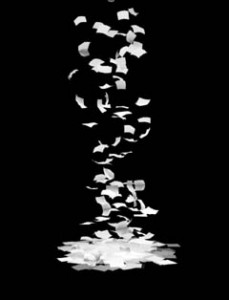In January 1996 the seventh National Summer School in Computer Generated Art and Interactive Multimedia for Artists was held at the Institute of the Arts Lab at the Australian National University in association with the Australian Centre for the Arts and Technology (ACAT).
The School is unique in that it provides the only intensive training program in Australia devised specifically for artists who do not necessarily have previous computer experience.
The tutors for the school this year were Linda Dement and John Tonkin, two of Australia’s leading new media artists. Marciano Telese, from the Australian Centre for the Arts and Technology (ACAT) also conducted sound workshops during the School. The school was held in a Macintosh lab at the Canberra Institute for the Arts, and students were taught programs such as Macromedia Director, Adobe Premier, Photoshop, Infini-D and Pagemill.

John Tonkin, These are the days, 1994
This year 14 artists were selected to participate in the school. They were:
- Elizabeth Abbott, Mt Gambier, SA
- Alastair Page, Hobart, Tas
- Phillippa Harvey, Sydney, NSW
- Louise Paramor, Melbourne, Vic
- Eliza Hutchinson, Melbourne, Vic
- Shiralee Saul, Melbourne,
- Jeremy James, Canberra, ACT
- William Seeto, Brisbane,
- Russell Milledge, Cairns, Qld
- Laurens Tan, Woollongong, NSW
- Ann Morrison, Sydney,
- Mark Themann, Melbourne, Vic
- Tony Newport, Adelaide, SA
- Trinh Vu, Adelaide, SA
A forum and open day was also held on Tuesday 23 January at the Canberra Institute for the Arts to coincide with the National Summer School. The forum emphasised the major contribution artists working with technology have made to the cutting edge of art practice and to the development of the fledgling multimedia industry. The intention of the forum was to generate dialogue between industry and artists, and provide the Summer School participants with an insight into the variety of ways that artists are participating in the production of multimedia content: from exhibition based work, to working in the commercial multimedia sector.
Speakers at the forum were:
- Linda Dement
- John Tonkin
- John Colette
- Shu Lea Cheang
- Lyn Tune
Dement spoke of the personal in her artwork, outlining her rigorous working methods and her desire to address issues of the body, women and representation in her highly luscious and confrontational CD Rom/artworks.
Tonkin took the audience through a vast array of his works, from his early elegant (and eloquent) computer generated video animation to his recent interactive via the collaborative visualisations he has undertaken with scientists.
Colette, head of multimedia at the Australian Film Television and Radio School discussed education and training issues facing artists and filmmakers working with interactive multimedia and ways of bringing artists into industry through training. John cautioned against being swept away in the recent multimedia hype, encouraging artists to work towards the exploration of the medium as means of developing a “language” for this new and potentially exciting medium – as yet still in its infancy.
Cheang, a Taiwanese/American artist, presented her highly innovative interactive site specific and web installation Bowling Alley. Reinventing the idea of community, Cheang links a gallery at the Walker Art Center with a bowling lane in Minneapolis and the virtual space of the World Wide Web. Public space, private zone. The Bowling Alley installation began as a collaboration with 10 other artists. “Reflecting on issues of access, power and desire from the fringe of the cyberzone, this collective hypertext formulates the ten pin matrix of web texts grabbed in that ten second stare.” In her talk, she also examined the collaborative process of developing the installation, working with the other artists and with 4 programmers to realise the work.
Tune, Sydney based artist and designer now working as a project designer on new media projects for Frontline Agency, undertaking a range of roles from designing and executing graphics to programming, addressed the current narrow perception of what an ‘artist’ is and discussed the changing role of artists in a multimedia environment. Lyn identified the multifarious ways is which artists can participate in the emerging multimedia or New Media (a term she prefers) industry, and stressed that the key to the success of multimedia product is the collaborative process of working as part of a multiskilled team. She identified as potential roles for artists image production, art direction, animation and programming, along with writing, sound, design and executive production.
As an adjunct to the forum, and in order that those attending the forum could view the results of the training being undertaken at the school, the summer school participants had prepared, with the assistance of the tutors, a demonstration of a range of the work they produced during the summer school. Despite the fact that they still had not completed the school, the Macromedia director demo had a fantastic array of the work in process in quick time movies, sound and still images.
70 people attended the forum, arriving to witness an airshow directly above the School of Art, and staying well into the evening to view the works (in progress) that had been produced by the artists attending the summer school.
The National Summer School received assistance from the Commonwealth Government through the Australia Council, its arts funding and advisory body, the ACT Department of Business, the Arts, Sport and Tourism, the South Australian Department for the Arts and Cultural Development, the Minister for Education and the Arts through Arts Tasmania, and was sponsored by the Queensland Office of Arts and Cultural Development, and by Tektronix Australia Pty Ltd. ANAT acknowledges the support of the Department of Industry Science and Technology and the Department of Communications and the Arts through the Multimedia Forum Program towards the forum on 23 January.
Tags: collaborative visualisations, multimedia content, omputer generated video animation




